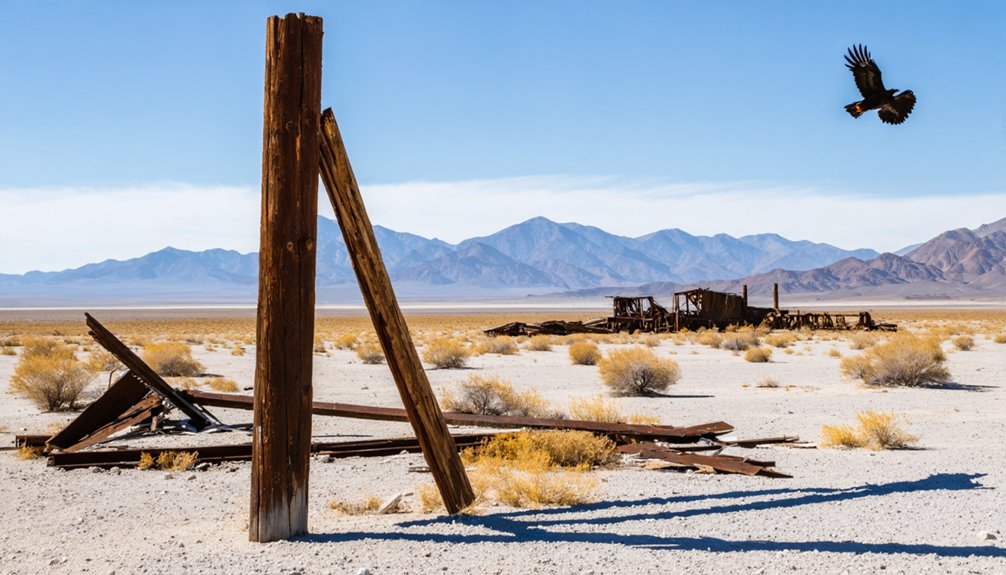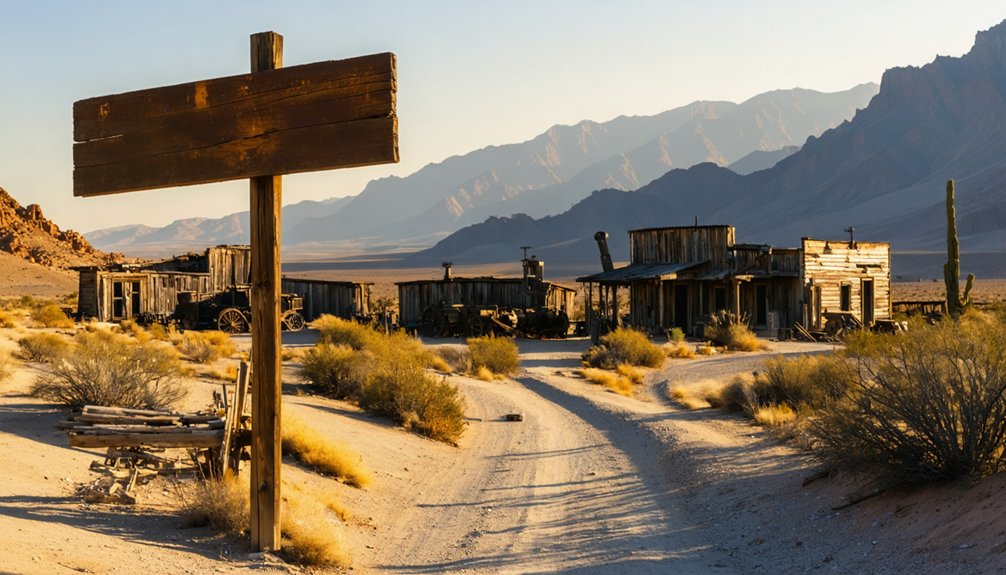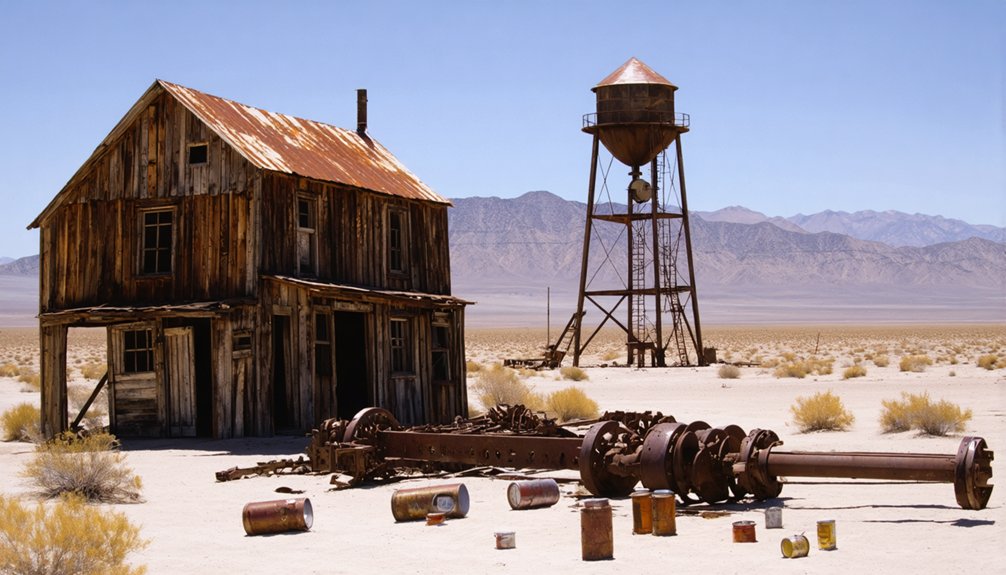Furnace, California emerged as a copper mining settlement in Death Valley’s Funeral Mountains during 1905-1909. Established by mining magnate Patsy Clark with $1.25 million in capital, the town briefly housed 500 residents before declining when copper deposits proved unprofitable. Unlike other ghost towns, Furnace has left virtually no physical traces, with harsh desert conditions erasing all structural evidence. The town’s documented history offers a window into California’s boom-and-bust mining era.
Key Takeaways
- Furnace was a copper mining settlement established in 1905 in Death Valley that was abandoned by 1909 due to unprofitable operations.
- At its peak (1905-1907), the town had approximately 500 residents before declining rapidly as mining operations ceased.
- Unlike other ghost towns, Furnace has no remaining physical structures due to harsh desert conditions erasing all visible traces.
- The community featured a clear social hierarchy with mine owners at the top and women playing crucial economic roles.
- Historical documentation and artifacts from Furnace are preserved in the Furnace Creek Ranch Museum and county historical records.
The Birth of Clark’s Camp in the Greenwater District
In the heart of Death Valley‘s unforgiving landscape, Clark’s Camp emerged during the early 1900s mining boom as the cornerstone of the Greenwater District.
The settlement’s story began in February 1905 when prospectors Fred Birney and Phil Creasor discovered rich copper deposits while searching for gold. They sent samples to mining magnate Patrick “Patsy” Clark, who purchased their claims and established operations by June with eight men working a 35-foot shaft.
The community dynamics quickly evolved as Clark incorporated the Furnace Creek Copper Company in 1906, capitalizing it at $1,250,000. Shares were sold at 50¢ each and were in such high demand that 125,000 shares sold within just three hours.
Mining techniques advanced with the installation of a 15-horsepower gas hoist as shafts reached 100 feet deep. Despite these developments, the mining district ultimately failed to yield profitable results, leading to its complete abandonment by 1909.
This first major operation in Greenwater set the stage for one of Death Valley’s most spectacular mining booms.
Patsy Clark: The Mining Mogul Behind Furnace
The rise of Clark’s Camp can’t be fully understood without examining the remarkable figure behind its development. Born in Ireland in 1850, Patsy Clark built his reputation across the American West, establishing Clark’s Legacy through shrewd investments and Mining Innovations.
His Furnace Creek Copper Company, capitalized at $1.25 million, demonstrated his exceptional business acumen when shares sold out within just three hours.
Clark’s impact extended beyond Furnace:
- He developed mines across multiple states, from Montana’s Bushwacker to Idaho’s Poorman Gold Mine.
- His international mining ventures stretched from British Columbia to Mexico.
- His magnificent 12,000-square-foot Spokane mansion stands as evidence of his success in the mining industry.
After the Great Fire of 1889 destroyed his previous home, Clark commissioned a new and improved mansion that was completed in 1898.
Clark founded the Furnace Creek Copper Company in Death Valley in 1906.
Copper Dreams and Desert Realities
Rich copper croppings gleaming across Greenwater Valley in 1905 launched what many believed would be one of California’s most productive mining districts. Fred Birney and Phil Creasor discovered the copper belt while hunting gold, setting off a frenzy of claim-staking and investment.
Patsy Clark’s Furnace Creek Copper Company capitalized on this excitement, incorporating with $1.25 million in capital stock. The district officially formed in July 1906, bringing rapid development.
Despite the optimism, copper extraction faced brutal desert realities. Water cost $15 per barrel, mining equipment had to be hauled over fifty miles of sandy terrain, and planned railroads never materialized. Similarly, the Afterthought mine experienced significant challenges when its smelter was destroyed by fire in 1911, hampering production capabilities. The Copper World mine on Clark Mountain also struggled with smelting operations, producing six to seven tons of copper matte daily when operational in 1899.
Peak Mining Operations (1905-1908)
During Furnace’s heyday from 1905 to 1908, mining operations expanded dramatically from their modest beginnings into a full-scale industrial enterprise.
What started as Patrick “Patsy” Clark’s eight-man team working a 35-foot shaft quickly evolved into an extensive underground network reaching depths of 480 feet by early 1907. Furnace Creek Copper Company invested in electric hoists and air compressors to support this rapid expansion, while the settlement grew to approximately 500 residents. Similar to the mines in Death Valley region, Furnace’s development coincided with a period when mining activity peaked between 1905 and 1907.
Despite the initial copper discovery excitement, mining operations faced significant challenges:
- Ore had to be transported over 50 miles across desert terrain to reach railway connections
- Underground copper lodes proved more elusive than surface findings suggested
- By late 1908, diminishing productivity signaled the operation’s unsustainability
The Vanishing Town: Why Furnace Disappeared
While copper mining operations initially flourished in Furnace, a combination of economic and environmental factors ultimately led to the town’s rapid demise after 1908. The richest veins had been exhausted, leaving only lower-grade ore that was increasingly unprofitable to extract. This mining challenge coincided with falling mineral prices and rising competition from other regions.
You would have witnessed a town in economic decline as miners and their families departed in droves. By 1910, the population had markedly decreased, triggering closures of schools, stores, and other essential services. The pattern of exhausted mines causing abandonment mirrors the typical lifecycle of boom-and-bust mining communities throughout the American West.
The remote desert location, with its persistent water scarcity and expensive transportation costs, further accelerated Furnace’s abandonment. Similar to George Air Force Base after its 1992 closure, the area became a toxic environment due to industrial contamination of the soil and water. With no alternative industries to sustain the community, Furnace was largely deserted by 1912, leaving the once-bustling mining town to decay into the desert landscape.
Life in a Boom-and-Bust Mining Camp
If you’d visited Furnace in its heyday, you’d have encountered a stratified social world where mine owners and investors stood atop a hierarchy that descended through skilled assayers and merchants down to the common laborers who performed backbreaking work in the copper mines.
You’d have noticed the overwhelming male population, with women appearing only in rare supporting roles as cooks, laundresses, or occasionally as the wives of more established residents.
Your comfort would’ve been minimal in this harsh desert outpost, where canvas tents provided little protection from Death Valley’s extreme temperatures, water remained scarce, and most residents endured primitive conditions while dreaming of striking it rich. The nearby Furnace Creek Inn, which opened in 1927 with just 12 guestrooms, eventually provided a stark contrast to the primitive living conditions of the mining town.
Harsh Desert Living Conditions
Life in Furnace, California presented extraordinary challenges that tested human endurance at every turn.
You’d face some of the most extreme weather conditions on Earth, with temperatures regularly soaring above 115°F while annual rainfall barely reached 2 inches.
Desert survival meant adapting to a harsh environment where resource management became your daily priority.
Consider what you’d endure:
- Water scarcity required strict rationing, with supplies often transported miles across scorching terrain.
- Makeshift shelters offered minimal protection from intense heat, dust storms, and cold desert nights.
- Health threats lurked constantly as heat exhaustion, dehydration, and limited medical care created a precarious existence.
Your freedom came with a steep price in this unforgiving landscape.
Mining Camp Social Hierarchy
The harsh desert conditions in Furnace weren’t the only challenge you’d face as a resident—a complex social structure governed every aspect of daily existence in this boom-and-bust mining settlement.
At the top of this labor hierarchy sat company owners and investors who controlled development and employment opportunities. Beneath them, educated specialists like assayers commanded respect and decent wages.
You’d find the backbone workforce—miners, furnace men, and carpenters—earning between $2.50 and $4.00 daily based on skill level. The social dynamics revolved around these occupational distinctions, with saloon owners and storekeepers forming an essential middle tier.
Daily life reflected this stratification. Your social interactions would primarily occur in boarding houses and saloons where men of similar standing gathered, especially on payday when the rigid social boundaries briefly loosened amid drinking and gambling.
Women’s Rare Frontier Roles
While men dominated the population of mining settlements like Furnace, women who braved the frontier found themselves in positions of unexpected economic leverage and social importance.
The extreme gender imbalance created unique opportunities for frontier entrepreneurship where women could earn substantial incomes providing essential services men couldn’t fulfill themselves.
The stark gender dynamics of mining communities like Furnace manifested in three distinct ways:
- Women often earned more than miners by operating boarding houses, cooking meals, or doing laundry.
- Indigenous women faced exploitation through forced labor, sexual violence, and displacement.
- Society divided women into “good” (domestic) and “bad” (prostitutes) categories despite both being economically essential.
You’d find women’s influence primarily confined to domestic spheres, yet their economic contributions proved fundamental to the mining community’s survival and functionality.
What Remains Today: The Ghost Site Explored
Unlike most ghost towns that offer curious visitors at least some crumbling foundations or weathered artifacts, Furnace, California presents an unusually barren experience for ghost town enthusiasts.
When you venture to this site located 6.5 miles northwest of Funeral Peak, you’ll find absolutely no structural remains—no foundations, no mill ruins, no mine openings that typically characterize Death Valley’s mining settlements.
The location exists today purely as a historical reference point rather than an archaeological site. You won’t find marked trails, interpretive signs, or even the scattered debris common at abandoned settlements.
This complete absence of physical evidence makes Furnace remarkable among Death Valley’s 100+ ghost towns. The harsh environmental conditions have erased all visible traces of this mining-era community, leaving only its memory in historical records.
Neighboring Ghost Towns of the Death Valley Region

While exploring Furnace, you’ll find the Death Valley region dotted with fascinating mining ghost towns like Panamint City, Rhyolite, and Skidoo, each with unique accessibility challenges ranging from strenuous hiking trails to high-clearance vehicle requirements.
These settlements once shared primitive transportation networks that connected mining operations, supply points, and residential areas despite the harsh desert terrain.
Water resources proved critical to each town’s survival, with settlements like Skidoo investing in elaborate pipeline systems while others struggled with limited access, ultimately contributing to their eventual abandonment.
Nearby Mining Boom Towns
Throughout the Death Valley region, numerous mining boom towns emerged alongside Furnace during the early 20th century, creating a constellation of settlements that shared similar trajectories of rapid growth and decline.
Greenwater and Copperfield sprang up in 1905 during the copper mining boom, with Greenwater reaching 2,000 residents despite water costing $15 per barrel. Neither town ever produced profitable copper, and both were abandoned by 1909.
Notable ghost towns you’ll find in the area include:
- Rhyolite – A Nevada boomtown with modern amenities including electricity and telephones, declining rapidly after Charles Schwab’s investments failed to yield profits.
- Chloride City – One of the earliest mining settlements, established in 1871 with only three stamp mills remaining today.
- Cerro Gordo – A silver mining powerhouse that operated from 1866 to 1957, now a historic landmark.
Transportation Between Settlements
Traversing the rugged terrain between Death Valley’s ghost towns presents unique challenges that require careful planning and appropriate vehicles. Most connections between these abandoned settlements consist of narrow, serpentine dirt roads constructed in the 1930s.
For ideal ghost town access, you’ll need a high-clearance, four-wheel-drive vehicle, especially after storms when conditions deteriorate rapidly.
While Rhyolite remains accessible by standard car, remote locations like Panamint City demand expert off-road driving skills or hiking.
Before attempting any journey, check current conditions at Furnace Creek Visitor Center, as GPS often proves unreliable in these remote areas. Travel safety depends on proper preparation—carry paper maps, extra supplies, and remember that cell service is nonexistent and help may be hours away.
Pay your entry fees in advance on Recreation.gov if entering via dirt roads.
Water scarcity shaped the fate of Death Valley’s ghost towns as profoundly as the minerals that first attracted settlers.
Furnace and neighboring Greenwater shared interconnected groundwater aquifers that fed vital springs and oases. The Timbisha Shoshone Tribe and local ecosystems depended on these same water sources that sustained mining operations.
Water distribution challenges were severe across settlements:
- Greenwater residents paid up to $15 per barrel for hauled water, establishing water supply as an essential business.
- Furnace Creek’s copper mining operations required water at depths exceeding 500 feet, straining limited resources.
- Modern mining claims near aquifer recharge zones threaten water quality that historically sustained these towns.
Today, aquifer protection efforts focus on preventing contamination and depletion of these fragile shared resources that connect ghost town histories to present environmental concerns.
Mapping Furnace’s Location in the Funeral Mountains

Nestled within the rugged expanse of the Funeral Mountains, the ghost town of Furnace occupied a remote location approximately 6.5 miles north-northwest of Funeral Peak.
This mining settlement was positioned in a challenging landscape where the Funeral Mountains form the eastern wall of Death Valley, straddling the California-Nevada border about 100 miles west of Las Vegas.
When examining Furnace’s geography through mining cartography, you’ll find it was part of a cluster including Greenwater and Copperfield camps.
The site was strategically located near Patsy Clark’s Furnace Creek copper mine, though access remained difficult due to the area’s minimal trails and rough terrain.
Today, no structures remain at Furnace, which sat in a changing zone between wilderness and the more developed Furnace Creek area.
Preserving the Memory: Historical Records and Archives
Although Furnace’s physical structures have vanished from the landscape, its historical footprint endures through meticulous documentation preserved in various archives and collections.
The ghost town documentation exists primarily through mining records from companies like Furnace Creek Copper Company and Greenwater Death Valley Copper Company that operated until around 1911.
The memory of Furnace lives on through corporate mining ledgers, the silent custodians of a desert boomtown’s fleeting existence.
For those interested in archival preservation efforts related to Furnace, you’ll find:
- Corporate documents transferred to Inyo County after mining companies abandoned their claims
- Collections at Furnace Creek Ranch Museum featuring artifacts from the region’s mining heritage
- Historical databases maintaining records of the town’s evolution from Clark’s Camp to its eventual abandonment by 1917
Unlike Rhyolite, Furnace lacks physical remains, making these preserved records invaluable for reconstructing its history.
Frequently Asked Questions
Were Any Major Mineral Discoveries Made After Furnace Was Abandoned?
After Furnace’s abandonment, you won’t find major copper discoveries in the area. While Rhyolite, Skidoo, and Keane Wonder yielded significant mineral wealth, no ghost town matched Furnace’s early promise.
What Happened to Patsy Clark After the Furnace Venture Failed?
Despite losing millions in Furnace Creek, Patsy Clark’s legacy endured through diversified mining investments in Canada and Mexico. You’ll find his most tangible post-Furnace venture lessons preserved in his magnificent Spokane mansion.
Did Any Furnace Residents Die in Mining Accidents?
You’ll find no documented evidence of Furnace residents dying in mining accidents. Despite mining safety concerns of that era, historical records don’t support such fatalities, though ghost stories sometimes claim otherwise.
What Indigenous Peoples Inhabited the Area Before Mining Began?
You’ll find the Timbisha Shoshone inhabited the Death Valley region before mining began. This Native Tribe maintained a continuous presence near Furnace Creek, with their cultural heritage evidenced by artifacts like Grinding Rock.
Can Visitors Legally Collect Artifacts From the Furnace Site?
No, you can’t legally collect artifacts. Federal and state laws, including the Archaeological Resources Protection Act, strictly prohibit removal of items from Furnace. Legal regulations emphasize artifact preservation to protect historical context.
References
- https://www.maxtour.co/death-valley-mysteries/
- https://www.hmdb.org/m.asp?m=159457
- https://digital-desert.com/furnace-creek-ca/history.html
- https://www.legendsofamerica.com/ca-furnace/
- https://www.youtube.com/watch?v=-Xt46GrPSAY
- https://www.nps.gov/deva/learn/historyculture/death-valley-ghost-towns.htm
- https://loyaltytraveler.boardingarea.com/2013/05/23/deserted-desert-hotel-at-furnace-creek-inn-death-valley/
- https://www.nps.gov/deva/learn/historyculture/rhyolite-ghost-town.htm
- https://en.wikipedia.org/wiki/List_of_ghost_towns_in_California
- https://www.oasisatdeathvalley.com/connect/stories/discover-the-eerie-ghost-towns-of-death-valley/



